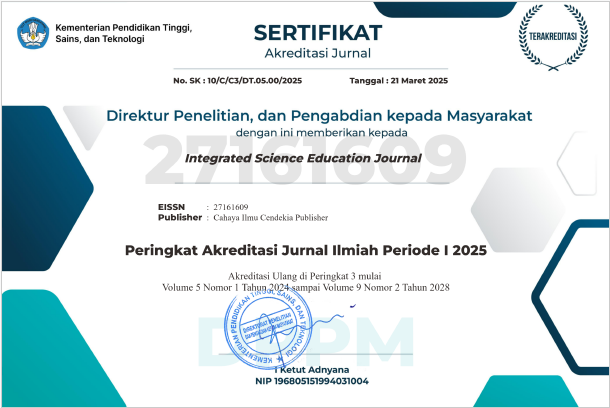Development of Integrated Learning Tools for Character Values in Science Subjects in Junior High School
Abstract
Purpose of the study: The purpose of this study is to provide learning tools along with Student Worksheets that are integrated with character values, to determine student responses to Student Worksheets contained in learning tools, and to determine the effectiveness of Student Worksheets.
Methodology: The development procedures used are ADDIE, Analysis, Design, Development, Implement, Evaluate, with a research design of one group pretest-postest design. The sample of the study was 33 grade VIII students, Junior High school 17 Jambi City. The instruments used are questionnaires, observation sheets of teacher and student needs, and documentation. The instruments used are obtained by adaptation.
Main Findings: The results of the teacher's response obtained an average score of 4 with a good category and the results of the average student response of 4.2 with a good category. The validation results of material experts and media experts were 3.9, Good category and 4.5, Very Good category, respectively
Novelty/Originality of this study: This research integrates character values into a learning tool equipped with Student Worksheets. From this research will help readers to know how to integrate character values into a learning tool.
References
M. K. Littrell., C. Okochi., A. U. Gold., E. Leckey., K. Tayne., S. Lynds., V. Williams., and S. Wise, “Exploring students’ engagement with place-based environmental challenges through filmmaking: A case study from the Lens on Climate Change program,” Journal of Geoscience Education, vol. 68, no. 1, pp. 80-93, 2020, doi: 10.1080/10899995.2019.1633510
H. Hairida., and V. Setyaningrum, “The development of students worksheets based on local wisdom in substances and their characteristics,” Journal of Educational Science and Technology, vol. 6, no. 2, 2020, doi: 10.26858/est.v6i2.12358
N. Anggraeni., and W. B. Suryanti, “Development of student activity sheets based on local wisdom to improve critical thinking skills of science 4th grade elementary school,” International Journal of Innovate Science and Research Technology, vol. 5, no. 7, pp. 952-958, 2020, doi: 10.38124/IJISRT20JUL690
H. A. López., P. Ponce., A. Molina., M. S. Ramírez-Montoya., and E. Lopez-Caudana, “Design framework based on TEC21 educational model and Education 4.0 implemented in a Capstone Project: A case study of an electric vehicle suspension system,” Sustainability, vol. 13, no. 11, pp. 5768, 2021, doi: 10.3390/su13115768
K. Dong-Joong, B. Sung-Chul., C. Sang-Ho., K. Hee-Jeong, “Creative character education in mathematics for prospective teachers,” Sustainabily, vol. 11, no, 6, pp. 1730-1746, 2019, doi: 10.3390/su11061730
A. Agboola., K. C. Tsai, “Bring Character Education into Classroom,” Euro. J. Edu. Res., vol. 1, no. 2, pp. 163-170, 2012, doi: 10.12973/eu-jer.1.2.163
S. Ramdiah., A. Abidinsyah., M. Royani., H. Husamah., and A. Fauzi, “South kalimantan local wisdom-based biology learning model,” European Journal of Educational Research, vol. 9, no. 2, pp. 639-653, 2020, doi: 10.12973/eu-jer.9.2.639
S. H. Hasan, “Pendidikan sejarah untuk memperkuat pendidikan karakter[History education to strengthen character education]”. Paramita, vol. 22, no. 1, pp. 81-95, 2012, doi: 10.15294/paramita.v22i1.1875
E. Suryawati., F. Suzanti., Z. Zulfarina., A. R. Putriana., and L. Febrianti, “The implementation of local environmental problem-based learning student worksheets to strengthen environmental literacy,” Jurnal Pendidikan IPA Indonesia, vol. 9, no. 2, pp. 169-178, 2020, doi: 10.15294/jpii.v9i2.22892
A. Prastowo, Panduan Kreatif Membuat Bahan Ajar Inovatif[Creative Guide to Creating Innovative Teaching Materials], Yogyakarta, Diva Press, 2012.
C. I. Abramson., and M. Levin, “Behaviorist approaches to investigating memory and learning: A primer for synthetic biology and bioengineering,” Communicative & Integrative Biology, vol. 14, no. 1, pp. 230-247, 2021, doi: 10.1080/19420889.2021.2005863
A. Hadi, Teori Belajar Behavioristik[Behavioristic Learning Theory]. dalam http://nudisaku.blogspot.com. 2013
W. Budiaji, “Skala pengukuran dan jumlah respon skala likert[Measurement scale and number of Likert scale responses],” Jurnal Ilmu Pertanian dan Perikanan, vol. 2, no 2, 2013, doi: 10.31227/osf.io/k7bgy
I. Patresia., M. Silitonga., and A. Ginting, “Developing biology students' worksheet based on steam to empower science process skills,” Journal of Biological Education Indonesia (Jurnal Pendidikan Biologi Indonesia), vol. 6, no. 1, pp. 147-156, 2020, doi; 10.22219/jpbi.v6i1.10225
S. Suhono., and D. A. Sari, “Developing students’ worksheet based educational comic for eleventh grade of vocational high school agriculture,” Anglophile Journal, vol. 1, no. 1, pp. 29-40, 2020, doi: 10.51278/anglophile.v1i1.78
R. Zhang., and D. Zou, “Types, purposes, and effectiveness of state-of-the-art technologies for second and foreign language learning,” Computer Assisted Language Learning, vol. 35, no. 4, pp. 696-742, 2022, doi: 10.1080/09588221.2020.1744666
A. Gumelar., S. S. Sitompul., H. Hamdani, “Pengembangan lembar kegiatan peserta didik (lkpd) berbantuan flip pdf professional pada materi tekanan hidrostatis[Development of professional student activity sheets (LKPD) with the help of flip pdf on hydrostatic pressure material],” Jurnal Ilmiah Profesi Pendidikan, vol. 7, no. 3b, pp. 1412-1417, 2022, doi: 10.29303/jipp.v7i3b.709
S. Suryaningsih., and R. Nurlita, “Pentingnya lembar kerja peserta dididk elektronik (e-lkpd) inovatif dalam proses pembelajran abad 21[The importance of innovative electronic student worksheets (e-LKPD) in the 21st century learning process],” Jurnal Pendidikan Indonesia (JAPENDI), vol. 2, no. 7, 2021, doi: 10.59141/japendi.v2i07.233
A. Syakur, “The effectiveness of english learning media through google classroom in Higher Education,” Britain International of Linguistics Arts and Education (BIoLAE) Journal, vol. 2, no. 1, pp. 475-483, 2020, doi: 10.33258/biolae.v2i1.218
R. Asma., A. Asrial., M. Maison, “Development of interactive electronic student worksheets on electromagnetic induction based on scientific approaches,” Jurnal Penelitian Pendidikan IPA, vol. 6, no. 2, pp. 136-143, 2020, doi: 10.29303/jppipa.v6i2.387
T. Ernawati., and S. Sujatmika, “Development of worksheet based on scientific approach to improve critical thinking skills. International Journal of STEM Education for Sustainability, vol. 1, no. 1, pp. 1-10, 2021, doi: 10.53889/ijses.v1i1.1
A. H. A. Sali., and A. C. Marasigan, “Madrasah education program implementation in the Philippines: an exploratory case study. International Journal of Comparative Education and Development, vol. 22, no. 3, pp. 201-217, 2020, doi: 10.1108/ijced-06-2019-0034
U. Umaroh., N. Novaliyosi., Y. Setiani, “Pengembangan lembar kerja peserta didik elektronik (e_lkpd) berbasis pbl untuk memfasilitasi kemampuan penalaran peserta didik pada materi lingkaran[Development of PBL-based electronic student worksheets (e-lkpd) to facilitate students' reasoning abilities on circular material],” Jurnal Inovasi Dan Risset Pendidikan Matematika, vol.3, no.1, 2022, doi: 10.56704/jirpm.v3i1.13368
D. K. Gurel., A. Eryilmaz., and L. C. McDermott, “A review and comparison of diagnostic instruments to identify students’ misconceptions in science,” Eurasia Journal of Mathematics, Science and Technology Education, vol. 11, no. 5, pp. 989–1008, 2015, doi: 10.12973/eurasia.2015.1369a
R. T. Sari., I. R. Jusar, “Analysis of science learning rocess by using learning module of character education oriented through quantum learning approach,” Jurnal Penelitian dan Pembelajaran IPA JPPI, vol. 4, no. 1, 2018, pp. 14-24, doi: 10.30870/jppi.v4i1.2252
K. Kustandi., C. Cecep., and B. Sutjipto, Media Pembelajaran Manual dan Digital Edisi Kedua[Manual and Digital Learning Media Second Edition], Bogor, Ghalia Indonesia, 2013.
R. Rasiman., D. Prasetyowati., K. Kartinah “Development of learning videos for junior high school math subject to enhance mathematical reasoning,” International Journal of Education and Practice, vol. 8, no. 1, pp. 18-25, 2020, doi: 10.18488/journal.61.2020.81.18.25
L P. Puriasih., N. W. Rati, “E-LKPD interaktif berbasis problem solving pada materi skala dan perbandingan kelas v sekolah dasar[Interactive e-LKPD based on problem solving on scale and comparison material for class v elementary schools],”Jurnal Pedagogi dan Pembelajaran, vol. 5, no. 2, 2022, doi: 10.23887/jp2.v5i2.48848
Y. Yusnidar, E. Epinur, and N. A. Nadila, “Analysis of Student Responses to Student Worksheets Based on Project Based Learning Models”, In. Sci. Ed. J, vol. 4, no. 3, pp. 111-116, 2023, doi: 10.37251/isej.v4i3.718
K. L. S. Utami., S. Suastra., S. Suarni, “Pengembangan E-LKPD berbasis liveworksheet untuk meningkatkan kemampuan berfikir kritis pada pembelajaran ipa tema sumber energi kelas IV SD[Development of live worksheet-based E-LKPD to improve critical thinking skills in science learning on the theme of energy sources for class IV elementary school],” Jurnal Pendidikan Dasar Indonesia, vol. 6, no. 2, 2022, doi: 10.23887/jurnal_pendas.v6i2.952
Copyright (c) 2024 Monita Monita, Rayandra Asyhar, Pinta Murni

This work is licensed under a Creative Commons Attribution-NonCommercial 4.0 International License.
Authors who publish with this journal agree to the following terms:
- Authors retain copyright and acknowledge that the Integrated Science Education Journal is the first publisher licensed under a Creative Commons Attribution 4.0 International License.
- Authors are able to enter into separate, additional contractual arrangements for the non-exclusive distribution of the journal's published version of the work (e.g., post it to an institutional repository or publish it in a book), with an acknowledgment of its initial publication in this journal.
- Authors are permitted and encouraged to post their work online (e.g., in institutional repositories or on their website) prior to and during the submission process, as it can lead to productive exchanges and earlier and greater citation of published work.







.png)
.png)






